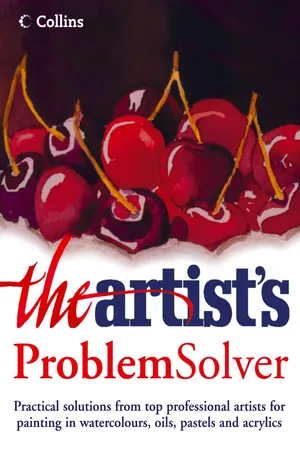eBook - ePub
About this book
This new ebook edition of the very successful hardback, published in association with The Artist magazine, provides practical solutions to many of the most common painting problems encountered by amateur artists.
Frequently asked questions
Yes, you can cancel anytime from the Subscription tab in your account settings on the Perlego website. Your subscription will stay active until the end of your current billing period. Learn how to cancel your subscription.
At the moment all of our mobile-responsive ePub books are available to download via the app. Most of our PDFs are also available to download and we're working on making the final remaining ones downloadable now. Learn more here.
Perlego offers two plans: Essential and Complete
- Essential is ideal for learners and professionals who enjoy exploring a wide range of subjects. Access the Essential Library with 800,000+ trusted titles and best-sellers across business, personal growth, and the humanities. Includes unlimited reading time and Standard Read Aloud voice.
- Complete: Perfect for advanced learners and researchers needing full, unrestricted access. Unlock 1.4M+ books across hundreds of subjects, including academic and specialized titles. The Complete Plan also includes advanced features like Premium Read Aloud and Research Assistant.
We are an online textbook subscription service, where you can get access to an entire online library for less than the price of a single book per month. With over 1 million books across 1000+ topics, we’ve got you covered! Learn more here.
Look out for the read-aloud symbol on your next book to see if you can listen to it. The read-aloud tool reads text aloud for you, highlighting the text as it is being read. You can pause it, speed it up and slow it down. Learn more here.
Yes! You can use the Perlego app on both iOS or Android devices to read anytime, anywhere — even offline. Perfect for commutes or when you’re on the go.
Please note we cannot support devices running on iOS 13 and Android 7 or earlier. Learn more about using the app.
Please note we cannot support devices running on iOS 13 and Android 7 or earlier. Learn more about using the app.
Yes, you can access The Artist's Problem Solver by in PDF and/or ePUB format, as well as other popular books in Art & Art Techniques. We have over one million books available in our catalogue for you to explore.
Information
1
SUBJECT SPOTLIGHT
How do I decide what makes a good subject for a painting?
Talk to any gallery and you will invariably find that subject matter has a major influence on the picture-buying public. But to the artist the relevance of a subject is that it is simply the vehicle through which to express yourself at the time.
To begin with, what you choose to paint will often be influenced by the work of other artists whose particular painting style you admire. Or there may be a tendency to search for idealized or picturesque images that fulfil the preconceived notion of what you think a subject ought to include.
There may also be a desire to paint personal favourites that possess an emotional attachment or contain an element of nostalgia. The painting process then becomes an exercise in producing a ‘nice’ picture. This approach should always be avoided since the solution to deciding what might make a good subject lies not so much in what you choose but more importantly in what will be your response to it and how you are able to interpret it.
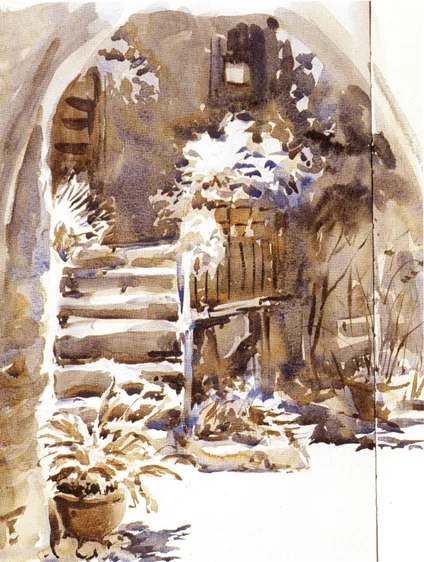
GARDEN, MALCESINE, ITALY
watercolour, 42 × 30 cm (107 × 75 in)
What caught my eye in this subject was the strong lighting. Strong tonal contrasts described the shapes of the elements in the picture. I made this sketchbook study using one warm colour, Burnt Sienna, and one cool colour, French Ultramarine. To maximize the impact of the light distribution I allowed the lightest areas to remain as white paper and then painted shapes rather than individual objects.
OBSERVATION
Recognizing potential subjects from your everyday environment or in seemingly ordinary or unlikely circumstances is an important part of artistic development. To do this you must first know how to look, in order to see with what is generally referred to as the ‘artist’s eye’. This means not merely looking, but observing nature in a particular way. Rather than looking at ‘things’ – flowers, still-life objects or elements in the landscape, for example – look particularly at the relationships between the various elements. Look for differing forms, shapes, lines formed between or linking different elements together, space, patterns and contrasts in tone, colour and textures. These more abstract qualities are the essentials of ‘seeing’ in artistic terms and should also be used as the criteria for selecting prospective subject matter. Images in which you can see a variety of these elements are likely to make the most worthwhile subjects for making a painting.
To understand this way of seeing more fully try looking at a view that you know well, first in the normal way, and then by observing the abstract qualities described. Notice the difference in your perception of what you are looking at. In practice this may be made easier by imagining everything to be on a flat plane, or try looking through one eye only to reduce the effect of distance. Even when not painting you can train your ‘artist’s eye’ by practising this way of seeing and soon it will become second nature.
SKETCHING
One reason why sketching is so important is that it exercises your ability in seeing. So explore your own visual environment, draw anything and everything, whatever happens to be in front of you. Do not just stick to your favourite subject matter.
Get into the habit of being a regular sketcher by always carrying a sketchbook and have it available for any convenient moment. There is an abundance of things around the home that can be used, from the general clutter inside the garden shed or garage to objects in the kitchen. Outside there are parks, gardens, parts of buildings or the clamour and hubbub of city streets; the choice is endless. The process of investigation through drawing will refine your visual awareness and awaken new directions for possible subject matter.
FINDING A FOCUS
How you are able to interpret what you see is also fundamental to your quest to find suitable subject matter. Images that contain a balanced composition with a well-defined focus will give clarity to a painting. Subjects do not have to be bustling with activity or depict wide vistas of landscape. A couple of flower stems in a jam jar, or other simple everyday things like brushes on a sink, can make rewarding subjects. Yet they are often overlooked, or not seen in the right way.
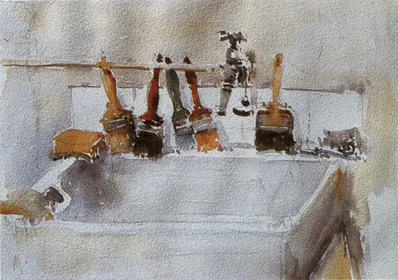
SKETCHBOOK STUDY
watercolour, 28 × 38 cm (11 × 15 in)
When you begin to see with an ‘artist’s eye’ you will discover potential subjects in even the most mundane situations. This display is almost a permanent feature in the corner of my studio and, though I look at it every day, until I painted it I realized I had not actually ‘seen’ it before.
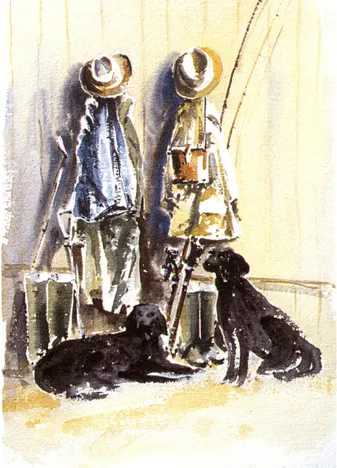
HALLWAY
watercolour, 53 × 38 cm (21 × 15 in)
Still-life images can be combinations of any objects. Ordinary everyday items, perhaps of little significance in themselves, combine to make an interesting subject.
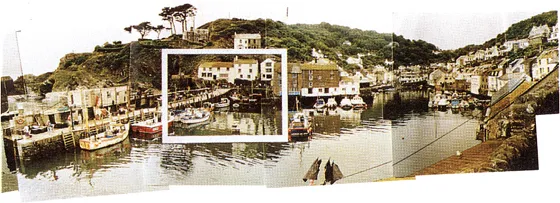
A viewfinder will help to isolate elements of a complex landscape view. The highlighted area is depicted in the drawing below.
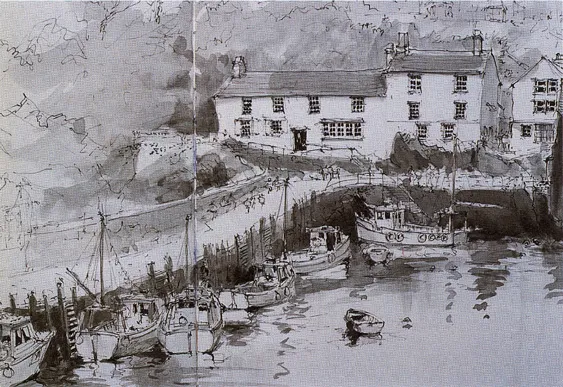
POLPERRO HARBOUR
pen and watercolour, 30 × 42 cm (75 × 107 in)
Drawing is a more rapid method of recording the essentials of a subject as the basis for a later studio painting. In this sketchbook drawing I included a monochrome watercolour wash to register the general tonal distribution.
Because our eyes take in an angle of vision of almost 180 degrees we have become accustomed to viewing the world on a wide screen. But painting requires you to focus on the particular, much like a spotlight in a theatre selecting one element of the performance at a time. For landscape work, looking through a viewfinder can be a useful aid. This can easily be made by cutting a 7.5 × 5 cm (3 × 2 in) hole in a piece of card which, when looked through at arm’s length, will enable you to see limited areas of the landscape in isolation.
This is useful for dissecting complex subjects, such as in Polperro Harbour. The photograph shows almost the full extent of the elevated field of view I had of a harbour setting. Though there were several subject opportunities here, I was attracted to the particular part of the scene, shown highlighted, by the tonal contrast between the white cottages set against the darker foreground elements, and the dominant angle of the harbour wall, which had the effect of leading the eye into the scene. I made the drawing to record the essential elements of the view. The addition of a monochrome wash also gave a record of the main tonal distribution.
Further opportunities for developing subject matter can be found by using on-the-spot drawings for later studio paintings, or by inventing subjects by combining parts from several drawings.

GARDEN CORNER
acrylic, 38 × 28 cm (15 × 11 in)
Many suitable subjects can be found in and around the home. This corner of my garden offered a ready-made composition with an amalgam of shapes, patterns and colours.
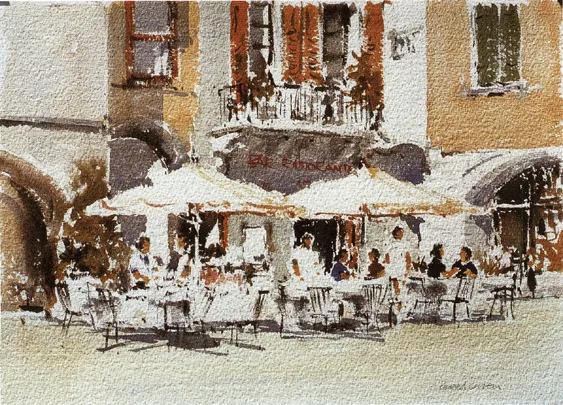
PAVEMENT CAFÉ
watercolour, 25 × 36 cm (10 × 14 in)
This subject focuses on a small corner within a busy area of pavement cafés. I wanted the painting to portray the essence of the subject as simply as I could without allowing it to become overworked with detail.
BRINGING SUBJECTS TO LIFE
Another major determinant in subject choice will be your ability and experience in using your chosen painting medium. If you are not adept at painting figures, for example, you will be far less likely to think of using them as possible subjects. But generally, whatever you choose, the best way to get the most from your subjects is to paint them in the most direct way you can. Aim for simplicity, both in your method of painting and means of expression. Do not try to create an exact copy, or produce a photographic likeness of your subjects.
Pavement Café illustrates a small corner of a large pedestrian piazza. I selected this area because the patterns of the shapes generated a lively composition, and my aim was to try to catch the essence of the subject with the minimum of detail.
Many of the problems that will confront you when painting can often be resolved by producing preliminary studies, either in monochrome or with limited colours, to help sort out doubts or uncertainties in the interpretation of your subjects. These can be small thumbnail sketches, or larger studies similar to Garden, Malcesine, Italy on page 8. This was produced using one warm and one cool colour to establish the distribution of tonal values, direction of lighting and colour temperature (the relative warm/cool colour relationships) within the proposed image.
Preliminary studies will also allow you to try out different colour combinations in which perhaps you wish to convey mood or atmosphere. In Winter Landscape t...
Table of contents
- Title Page
- Copyright
- Contents
- Introduction
- 1. Subject Spotlight
- 2. Centre of Interest
- 3. Creating Depth
- 4. Seven-minute Skies
- 5. The Longer View
- 6. Floral Still Lifes
- 7. Sense of Movement
- 8. Clues & Illusions
- 9. Tonal Strength
- 10. Soft Garden Colours
- 11. Painting Skies
- 12. Figures in Paintings
- 13. Woodland Scenes
- 14. Shapes & Rhythms
- 15. Unity in Still Lifes
- 16. Children at Play
- 17. Illusion of Light
- 18. Life in Landscapes
- 19. Landscape Greens
- 20. Street Life
- 21. Broken Colour
- 22. Control of Detail
- 23. Design & Movement
- 24. Rescue Strategies
- Keep Reading
- About the Publisher
